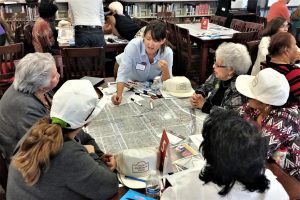As new development creeps into Little Havana, a master plan is in the works aimed at preserving the historic character and the pre-World War II architecture in Miami’s most famous neighborhood.

Residents gather at a workshop Saturday (Credit: Francisco Alvarado)
On Saturday morning, more than 100 residents and merchants participated in a community workshop at Miami Senior High School to formulate big picture ideas for the master plan, which is being developed by urban planning firm Plusurbia Design in conjunction with the National Trust for Historic Preservation, Dade Heritage Trust and Live Healthy Little Havana.
A majority of the participants reached consensus on restoring and reusing historic buildings, ensuring new construction is contextual and compatible with Little Havana, creating more affordable housing, community and cultural centers and making the neighborhood more pedestrian and bicycle-friendly.
“At the end of the morning, we asked each table to give us their big ideas,” Megan McLaughlin, the project planning leader for Plusurbia, said. “We are going to use those to guide our reports and our suggestions to the city.”
Plusurbia hopes to complete a final draft of the master plan by July, McLaughlin said. “We would present it to the city for them to consider,” she said. “The goal is to come up with heights, density, setbacks and floor lot ratios that matches what is there and is respectful of what is there.”
More than a year ago, the national trust began efforts to designate Little Havana a national treasure, an honor that was officially bestowed in late January, McLaughlin said. At the time the designation was made, Live Healthy Little Havana awarded grants for the Plusurbia master plan and a streets plan being developed by Urban Health Partnerships. “The grant allows us to look at what zoning could be that is compatible with the existing neighborhood and allows healthy new development,” she said.
Little Havana’s proximity to the urban core is making the neighborhood an attractive alternative for investors and developers, many buoyed by Greystar’s $89 million purchase late last year of the InTown apartment complex developed by Astor Companies. Nearby, a company controlled by Ana V. and Pedro O. Rodriguez has been approved to build a 12-story, 96-unit residential building at 45 Southwest Eighth Avenue that will also include 44,525 square feet of commercial space, 311 parking spaces and 15 bicycle parking spaces.
During the workshop, PlusUrbia founder and director Juan Mullerat told attendees Little Havana hasn’t experienced the level of real estate development seen in Brickell, Edgewater and Wynwood because of the city’s zoning code, Miami 21.
“Unfortunately, it has not led to much improvement in Little Havana,” Mullerat said. “We haven’t seen much investment in Little Havana, yet it is the second most dense neighborhood in Miami-Dade County.”
The master plan would strike a balance between encouraging new development while giving property owners and developers incentives to preserve and renovate Little Havana’s signature three-story apartment buildings from the 1920s. “They are very unique,” Mulleret said. “You can’t find them anywhere else.”
Lee Hernandez, a Little Havana homeowner since 1977, said the neighborhood needs an infusion of urbanism from Flagler Street to Northwest Fifth Street, between Northwest Fifth Avenue and Northwest 12th Avenue. “That area needs to be revitalized,” she said. “We need more greenery, we need more open spaces, and we need more places where people feel safe.”
Hernandez said she would welcome rational development in Little Havana. “Developers are investing slowly, but surely,” she said. “I would like to see urbanization with consciousness. We don’t want skyscrapers. We need to keep the flavor.”
